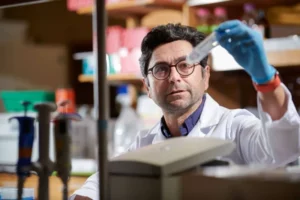
Team members
Katia Idir
Chronic Pain: Molecular and Cellular Mechanisms
Our team explores the mechanisms through which tissue and nerve injury produce changes in the peripheral and central nervous system, resulting in persistent pain.
Chronic pain affects one third of the world population creating tremendous suffering and disability. Its societal cost is more than diabetes, cancer and heart disease combined. Despite these facts, very little is known about how pain becomes chronic. Mounting evidence suggests that loss of spinal inhibition (disinhibition) is one of the most important underlying mechanisms of chronic pain. Our team’s goal is to decipher the molecular and cellular mechanisms underlying the transition from acute to chronic. To address these questions, we are using a multidisciplinary approach combining mouse genetics, behavioral pharmacology, omics and ex-vivo electrophysiology. In particular, (i) we are studying the role of TAFA4; a C-LTRMs-enriched secreted neurokine in modulation of gating neurons activity, (ii) we address the role of the C-LTMRs themselves in modulation of injury-induced mechanical pain, (iii) we are studying how loss-of-function of a gut-enriched atypical myosin protein (Myo1a) predisposes mice to develop chronic pain in a sexually dimorphic manner. Our team is also getting more and more interested in understanding the molecular and cellular mechanisms underlying sex-related differences in chronic pain
Publications
TAFA4 relieves injury-induced mechanical hypersensitivity through LDL receptors and modulation of spinal A-type K + current
Sensory neuron-derived TAFA4 promotes macrophage tissue repair functions
Loss of bhlha9 impairs thermotaxis and formalin-evoked pain in a sexually dimorphic manner
GINIP, a Gαi-Interacting Protein, Functions as a Key Modulator of Peripheral GABAB Receptor-Mediated Analgesia.
TAFA4, a Chemokine-like Protein, Modulates Injury-Induced Mechanical and Chemical Pain Hypersensitivity in Mice
Gut microbiota promotes pain chronicity in Myosin1A deficient male mice
A novel Nav1.8-FLPo driver mouse for intersectional genetics to uncover the functional significance of primary sensory neuron diversity
Sex-related exacerbation of injury-induced mechanical hypersensitivity in GAD67 haplodeficient mice.
Diverse roles and modulations of I A in spinal cord pain circuits
TAFA4 relieves injury-induced mechanical hypersensitivity through LDL receptors and modulation of spinal A-type K + current
TrkA specific signalling pathways are critical for mechanical allodynia development and bone alterations in a mouse model of rheumatoid arthritis
Sensory neuron-derived TAFA4 promotes macrophage tissue repair functions
Loss of bhlha9 impairs thermotaxis and formalin-evoked pain in a sexually dimorphic manner
A cell fitness selection model for neuronal survival during development
5-oxoETE triggers nociception in constipation-predominant irritable bowel syndrome through MAS-related G protein-coupled receptor D
TAFA4 Reverses Mechanical Allodynia through Activation of GABAergic Transmission and Microglial Process Retraction
Disruption of TRPV3 Impairs Heat-Evoked Vasodilation and Thermoregulation: A Critical Role of CGRP
Genetic ablation of GINIP-expressing primary sensory neurons strongly impairs Formalin-evoked pain.
The Low-Threshold Calcium Channel Cav3.2 Determines Low-Threshold Mechanoreceptor Function.
GINIP, a Gαi-Interacting Protein, Functions as a Key Modulator of Peripheral GABAB Receptor-Mediated Analgesia.
Acute heat-evoked temperature sensation is impaired but not abolished in mice lacking TRPV1 and TRPV3 channels.
Uncoupling of Molecular Maturation from Peripheral Target Innervation in Nociceptors Expressing a Chimeric TrkA/TrkC Receptor.
Peripheral pain-sensing neurons: from molecular diversity to functional specialization.
TAFA4, a Chemokine-like Protein, Modulates Injury-Induced Mechanical and Chemical Pain Hypersensitivity in Mice
Heterogeneity in primary nociceptive neurons: from molecules to pathology.
stac1 and stac2 genes define discrete and distinct subsets of dorsal root ganglia neurons.
Hepatocyte growth factor-Met signaling is required for Runx1 extinction and peptidergic differentiation in primary nociceptive neurons.
TRPV3 in keratinocytes transmits temperature information to sensory neurons via ATP.
Impaired thermosensation in mice lacking TRPV3, a heat and camphor sensor in the skin.
Expressing TrkC from the TrkA locus causes a subset of DRG neurons to switch fate.
News
Discover how members of our community are making an impact outside the walls of the institute through public outreach and creative initiatives.
We’re pleased to share some great news about our researchers’ achievements! Several projects from our teams have been selected for funding by the ANR and FRM, highlighting their hard work and innovative research.
Chronic pain starts from the gut
Alterations in gut microbiota composition promotes chronic somatic pain in Myosin1a-deficient male mice.
Several awards for IBDM members !
Our findings provide mechanistic insight into the mechanism by which TAFA4 reverses injury-induced mechanical hypersensitivity, by restoring normal spinal neuron activity, and highlight the considerable potential of TAFA4 as a treatment for injury-induced mechanical pain.
Ardem Patapoutian, shares the honours of his Nobel Prize with his former post-docs and students
Ardem Patapoutian shares the honours of his Nobel Prize with his former post-docs and students including Aziz Moqrich, Chronic pain : Molecular and cellular mechanisms
Tafalgie Therapeutics is a new start-up company created in November 2020, based on the work of Aziz Moqrich’s team “Chronic pain: cellular and molecular mechanisms” at IBDM.
Loss of bhlha9 impairs thermotaxis and formalin-evoked pain in a sexually dimorphic manner
In their study published in Cell Reports, Bohic et al. confirm the role of C-LTMRs in inflammatory pain modulation by inactivating the transcription factor bhlha9 particularly enriched in these touch neurons.
Required: MSc in physics, biophysics, acoustics, molecular or cellular biology, neurosciences or a related discipline.































